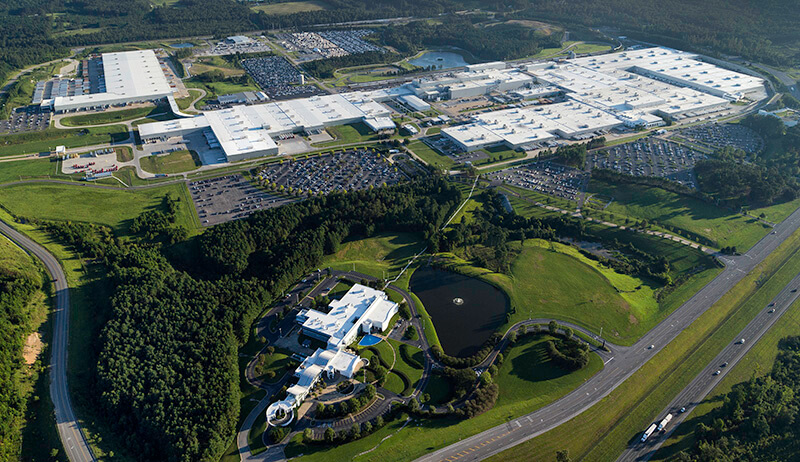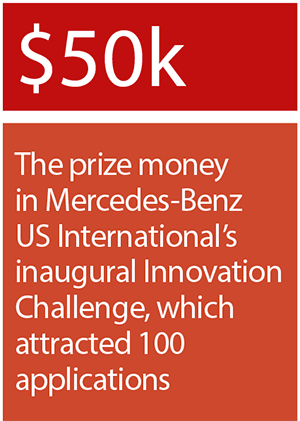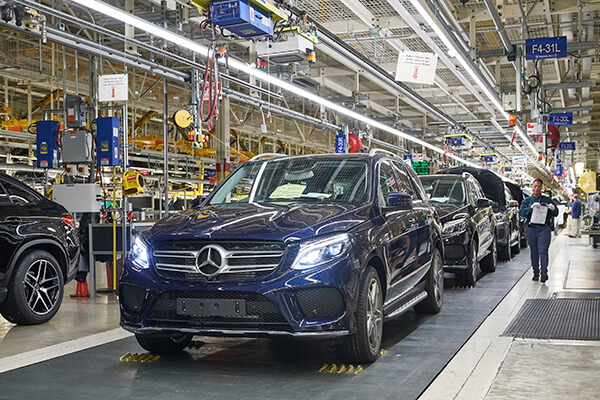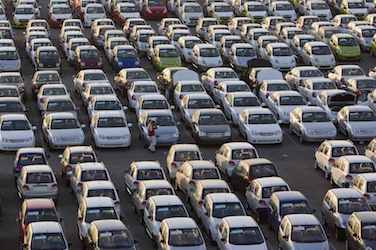 In June this year, Mercedes-Benz US International (MBUSI) announced the outcome of its inaugural Innovation Challenge, a competition for start-ups which promised $50,000 in prize money as well as the alluring prospect of a contract with Mercedes-Benz in the US, and perhaps also its global parent, Daimler AG.
In June this year, Mercedes-Benz US International (MBUSI) announced the outcome of its inaugural Innovation Challenge, a competition for start-ups which promised $50,000 in prize money as well as the alluring prospect of a contract with Mercedes-Benz in the US, and perhaps also its global parent, Daimler AG.
Not entirely philanthropic, the contest was also designed to connect the carmaker with agile start-ups offering new approaches to what it terms ‘critical challenges’ in production flow management, big data and digital communications.
 “One of the things we wanted to get out of this was to see some of their outside-the-box ideas that we wouldn’t traditionally do on our own,” Jason Hoff, president and CEO of MBUSI, said of the initiative.
“One of the things we wanted to get out of this was to see some of their outside-the-box ideas that we wouldn’t traditionally do on our own,” Jason Hoff, president and CEO of MBUSI, said of the initiative.
One of two winners chosen this summer was AutoMap, a four-year-old technology business based in Hillsboro, Oregon. It has created a wireless product for tracking inventory on car dealers’ sites, but earlier this year spotted even bigger opportunities in finished vehicle logistics.
“We were invited to a logistics conference,” recalls Mark Sargeant, vice-president of business development at AutoMap. “The entire conference, from what I heard, was people complaining about transparency – not knowing where vehicles were and dealing with inconsistencies. I said to myself: this is what AutoMap was made for.”
This year’s MBUSI Innovation Challenge attracted more than 100 registrations from entrepreneurs and start-ups, leading to 29 full entries, nine finalists and two winners. Apart from AutoMap, the other winner was Doks, a start-up offering drone-based aerial inventory tracking and recording.
The Innovation Challenge was staged in partnership with Startup Autobahn, a larger scheme to support innovation, which was established by Daimler in May 2016. It aims to accelerate promising start-ups with working space and resources, as well as access to potential customers, investors, mentors, universities and government agencies.
Among the notable winners to date is What3words, selected as one of Startup Autobahn’s second wave of innovators in February 2017. What3words has divided the entire globe into 57 trillion squares measuring three metres square, and has given each square a unique three-word address, translated into various languages.
 This makes it possible to communicate a precise location even in the absence of formal street addresses, with much greater simplicity than using longitude and latitude coordinates. The three English words “chart, punk, reform”, for example, pinpoint the south side of Nelson’s Column in the middle of London, England. The approach makes it simple to accurately specify destinations using text or voice input.
This makes it possible to communicate a precise location even in the absence of formal street addresses, with much greater simplicity than using longitude and latitude coordinates. The three English words “chart, punk, reform”, for example, pinpoint the south side of Nelson’s Column in the middle of London, England. The approach makes it simple to accurately specify destinations using text or voice input.
Just a year after its selection, the What3words system began to be rolled out as part of the new MBUX infotainment system fitted to the latest generation of Mercedes-Benz cars. The pace of adoption underscores the scheme’s aims of rapidly fostering innovation.
Locating the assetsAutoMap’s technology was developed to determine exactly where particular cars are located, with an exceptionally low tolerance for error. “We were approached by a bank that wanted to be able to securely audit dealers that had borrowed money to purchase vehicles; to do a collateral check,” Sargeant says. The AutoMap team had already worked with RFID tracking but knew this technology would not meet the bank’s exacting requirements.
“They say RFID can be secure, with tamper-proof tags, but I haven’t found a determined dealer that couldn’t spoof the system,” Sargeant explains. “We’ve seen a salesperson remove an RFID tag, hang it on a tree branch, and hide the car, because they want that sale and don’t want any of their co-workers finding the car.”
What AutoMap developed instead was a module that plugs directly into the car’s OBD (onboard diagnostics) port, using low-power Bluetooth technology to securely broadcast key data about the vehicle, including its VIN. The signal can be picked up by the Bluetooth receiver of a smartphone whenever it comes within a few yards.
Since information flows only in one direction, from module to smartphone, there is no need to establish a Bluetooth pairing beforehand, allowing the smartphone to pick up data from an unlimited number of modules as the phone’s user moves around a large parking lot or marshalling yard. The signal is encrypted for security, making the data inaccessible to unauthorised users; and the data is unscrambled not within the handheld itself, but by the system’s cloud-based server software. A smartphone app simply picks up the Bluetooth digital message and forwards it via its mobile or wi-fi data connection.
Once the back-end system has unlocked the encrypted data, the smartphone can present further information to authorised users about the status and location of particular vehicles. Desktop or laptop computers can also securely access information via the system’s online management interface.
When every car in a lot is fitted with its own OBD module and every worker in the yard receives signals as they move about, the back-end system is able to build and maintain an accurate location map of where every car is parked. Whenever a car is moved by a team member carrying their smartphone, the changing position will be automatically registered in real time. And even if, for some reason, a smartphone is not present when a car moves, the change in position will be picked up the moment someone else’s phone passes within range.
“It’s like crowd-sourcing,” Sargeant says. “Every time you move a car, not only is the car you’re moving updated, but the location of every car you pass by is registered – either reaffirming its position or updating it, if it’s been moved in the absence of a phone. If you’ve got 20 people running around your lot moving cars, you’re going to see every car many times every day.”
The data collected is both secure enough and reliable enough to meet the original business case of the bank’s collateral audit. “We partnered with Ally Bank here in the US,” Sargeant says. “We went through all their security inquiries and testing procedures. Our device ensures that the signals come from legitimate cars, not from an emulator or anything else that might be spoofing the system.”
“One of the things we wanted to get out of this [Innovation Challenge] was to see some of their outside-the-box ideas that we wouldn’t traditionally do on our own.” - Jason Hoff, MBUSI
The largest dealer to adopt AutoMap so far has about 4,000 cars on its lot, Sargeant says. “The bank used to send six auditors for four days to make sure they touched every car. Now they send one auditor for half a day, to take care of any exceptions.”
Tracking at TuscaloosaThe business case for applying AutoMap at Mercedes-Benz is, naturally, somewhat different; the finished vehicle yard at the Tuscaloosa plant in Alabama typically contains 7,000-8,000 cars at a time. “They deal with a lot of barcode scanning, which opens up the risk of human error,” Sargeant explains.

Even small errors or omissions in scanning there would mean that the yard management system falls out of step with reality. Mixing up just one out of a hundred scanning or data input operations in a yard the size of Plant Tuscaloosa’s might mean 70-80 vehicles being misplaced. A car mistakenly deposited in, say, slot D18 instead of D81 might prove hard to track down afterwards.
AutoMap removes all human interaction from the tracking process, which is what interested Mercedes, Sargeant says. “They’ve got people from repair, from accessories, coming and grabbing the cars and taking them. The last known location was wherever a driver last scanned it in, so they didn’t know [the real-time location].”
As well as mapping VINs against locations, AutoMap can also collect whatever pertinent data is available via the OBD port. “The cars all leave the factory in transport mode,” Sargeant says. “If we want to know estimated battery life, we’re able to pull that information from the car, just as one example.”
AutoMap’s back-end system can be configured to generate alerts whenever a car reports a low battery charge, as well as identifying the time, VIN, location and precise battery state. The handheld app can then guide a yard worker to the problem via a pin in Google Maps, so the car can be pulled out for charging or battery replacement.
 AutoMap’s modules are configurable and can collect and broadcast whatever OBD data the customer needs, Sargeant says. “Mercedes wants to know information on their vehicles that we can only get from proprietary codes in their computer system,” he explains. “They’re able to provide us with those codes and we’re able to get them what they need to know.”
AutoMap’s modules are configurable and can collect and broadcast whatever OBD data the customer needs, Sargeant says. “Mercedes wants to know information on their vehicles that we can only get from proprietary codes in their computer system,” he explains. “They’re able to provide us with those codes and we’re able to get them what they need to know.”
In addition to roaming smartphones, the AutoMap system can also collect status data using high-gain antennas, which Sargeant says can read the low-power signals from Bluetooth modules from as far as 100 yards away. Therefore a network of antennas can easily monitor a large yard.
“We record whenever a car starts,” Sargeant notes. “So if it’s a dealer lot, after hours, and somebody starts a car when nobody’s supposed to, we can send an alert. Or if we have a thief who takes the module out, we can detect the loss of signal. The system is intelligent enough to work out that if there is plenty of battery life, there’s no reason to have lost the signal, and to send an alert for that as well.”
Gaining momentumSargeant says news of AutoMap’s win with MBUSI has already triggered interest from other car manufacturers. “Because we’ve been able to prove that we can do this, it’s attracted the attention of other OEMs,” he says, though he cannot give details just yet. AutoMap also foresees wider applications across the outbound supply chain.
“We provide APIs [application programming interfaces] that offer easy integration into other systems,” Sargeant says. “You’re able to go in and look for specific cars. Let’s say a transporter is picking up eight cars: we can put those VINs into the system and get taken straight to those eight cars, so the right cars are loaded onto the truck.”
[mpu_ad]An OEM like Mercedes could install Bluetooth modules on the production line and have them stay with the car right through to the end customer, Sargeant adds. “Our modules are reusable, inexpensive and easy to use. Our vision is to have the transport companies use our system as well, tracking cars as they leave the site all the way through to the dealership, where the system can be used on the lot.”
The modules would then be removed at the last step of delivery, before being collected, boxed up and sent back to the factory for reprocessing and reuse.
That end-to-end scenario remains just a vision for now, but the ability to accurately track vehicles from factory to customer, seamlessly and without human error, is a capability that adds such value that it must surely emerge soon by one means or another.
“Our vision is to have the transport companies use our system as well, tracking cars as they leave the site all the way through to the dealership, where the system can be used on the lot.” - Mark Sargeant, AutoMap
 The biggest issue faced by the many operators of finished vehicle yards is managing complexity, says Paul Nurse, CEO of ProAct International, a company that provides a suite of yard management software systems to the finished vehicle industry.
The biggest issue faced by the many operators of finished vehicle yards is managing complexity, says Paul Nurse, CEO of ProAct International, a company that provides a suite of yard management software systems to the finished vehicle industry.
“That’s what all these sites are about: multiple tasks, multiple vehicles, different types of models, whether they’re hybrid, diesel, electric, or whatever, and all the different processes they might potentially go through,” he says.
Efficient decision-making is, therefore, a vital task for yard management systems, Nurse stresses. “We know from the VIN that a vehicle has certain characteristics, where it’s going, where it’s come from and a whole bunch of other attributes,” he says. “Based on those things, we know it needs to go down a particular process, but that’s not static, because you can get some way down the process and something happens – damage, as a simple example. Then the system has to re-evaluate and re-plan.”
On top of these process requirements are other operational factors, such as high-priority vehicles that need to jump queues; resource and personnel constraints; and overall efficiency.
Ruggedised handheld devices are typically used to tell drivers in the yard what to do: which vehicle they need to pull out next and which particular station to take it to. “All of those instructions are system-driven,” says Nurse. “We’re always looking for efficiencies. So if somebody has to park a car in bay A16 and the system recognises that another car needs to be pulled out of bay A18, obviously the logical thing is for the system to give the second job to the same driver. The system does that dynamically, making a real-time assessment of what to do next.”
Vehicles can also be moved around in a structured fashion that keeps them largely out of each other’s way, minimising the likelihood of accidental damage.
Human error does creep in, of course. “Accuracy is part of the puzzle,” Nurse notes. “One of the things that’s going to change all that is the use of telematics from the vehicles themselves.”
Gleaning data directly from the cars will alter many of the tasks that are automatically scheduled today. “For example, you might charge a car’s battery every 30 days,” Nurse says. “In the future, the vehicles themselves will be able to say when they have a problem and notify us through telematics – whether it’s a low battery or low fuel, or whatever it might be. Then we can schedule action. So a lot of the triggers we use today, essentially on an arbitrary schedule, will be driven by the vehicle itself and its real-time status.”
A shift in perspectiveNurse says the Association of European Vehicle Logistics (ECG), is working to standardise this kind of telematics for the supply chain. “Most [telematics] information today is targeted at the consumer end of the process. What we’re pushing for – and what the industry is realising – is that a lot of that information is important from a supply chain perspective.”
Many cars are shipped with their onboard systems in a dedicated transport mode already, Nurse adds, so there is a need to establish what data should be provided in this mode and how it should be accessed. “Battery maintenance is key, so you can’t be sending thousands of messages [over cellular networks]. It has to balance out what’s useful against the cost and the battery drain.”
Nurse adds that this kind of standardisation work needs to be completed quickly. “Car manufacturers are putting so many technology capabilities within vehicles that there’s a danger they may run ahead of the standards. That’s the key thing now: ensuring standards get out to the market fast enough for them to be adopted.”
Going forward, yard operators are highly focused on improving accuracy, speeding up processes and minimising damage, Nurse says. “Those are the things they want: to get there on time and to stamp out damage.”
In the background, of course, the industry is changing dramatically. “There’s the whole move towards made-to-order, tailored vehicles bought online, meaning fewer inventory vehicles and perhaps more and more added-value activities being done in the yard,” Nurse predicts.
Similarly, electric vehicles will need different kinds of attention from their fossil-fuelled counterparts, he points out. “The way we order cars and the technology onboard will both change the processes we use,” he comments.
Beyond this, there is the looming prospect of fully autonomous cars, which will be able to move themselves around a marshalling yard under direct software supervision and perhaps, ultimately, drive straight from the factory to the customer without human intervention.
That should eliminate the kind of human errors that creep into today’s processes, and is likely to alter finished vehicle logistics beyond all recognition.
“In the future, the vehicles themselves will be able to say when they have a problem and notify us through telematics – whether it’s a low battery or low fuel, or whatever it might be. Then we can schedule action. So a lot of the triggers we use today, essentially on an arbitrary schedule, will be driven by the vehicle itself and its real-time status.” - Paul Nurse, ProAct International

























![Global[1]](https://d3n5uof8vony13.cloudfront.net/Pictures/web/a/d/s/global1_726550.svgz)









